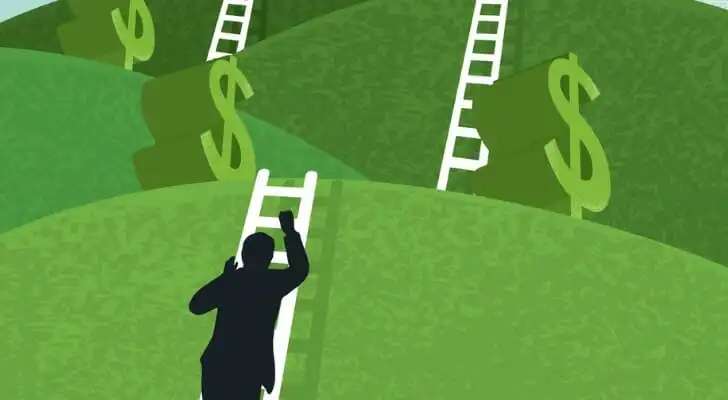Investing doesn’t have to involve high risk or complex strategies. A bond ladder is a simple approach that can help you earn steady income over time. It works by spreading investments across bonds with different maturity dates, so some come due regularly. This creates a predictable cash flow and reduces exposure to interest rate changes. For people who want to protect their savings while still growing their money, a bond ladder offers a low-risk way to stay invested.
A financial advisor could help you figure out how this fixed-income security could fit into your financial plans.
What Is a Bond Ladder?
A bond ladder is an investment strategy designed to provide a fixed income stream while managing interest rate and reinvestment risks. It involves purchasing a series of bonds with staggered maturity dates, creating a “ladder-like” structure where each rung represents a bond maturing at a different time. As each bond matures, the principal is typically reinvested into a new bond with a longer-term maturity, maintaining the ladder’s structure.
Similar to a CD ladder, a bond ladder is a portfolio of fixed-income securities with different points of maturity. Each bond is a rung on the ladder, and the proceeds can be continually reinvested once the bond reaches maturity.
This approach ensures that the investor has periodic access to cash while benefiting from potentially higher yields on longer-term bonds. By diversifying maturity dates, a bond ladder helps smooth out the impact of interest rate fluctuations and offers a balanced combination of liquidity, income and financial stability.
How to Make a Bond Ladder
Creating a bond ladder is fairly straightforward. A financial advisor can help you build one, or you can follow these steps to do it yourself:
- Determine your investment goals and time horizon: Begin by deciding how much money you want to invest and how long you want the ladder to last. Your time horizon will influence the maturity dates of the bonds you choose. For example, if you plan to use the income for retirement in 10 years, your ladder should align with that timeline.
- Decide on the ladder’s structure: Choose the number of rungs (bonds) in your ladder and the intervals between their maturities. For instance, you might create a five-year ladder with bonds maturing each year, or a ten-year ladder with bonds maturing every two years. A shorter interval between maturities provides more frequent access to cash.
- Select the bonds: Look for high-quality bonds that align with your risk tolerance. Options include government bonds, municipal bonds, or investment-grade corporate bonds. Ensure the bonds have staggered maturity dates to maintain the ladder’s structure. Consider the credit rating and yield to maturity of each bond.
- Purchase the bonds: Allocate your investment amount evenly across the chosen bonds. For example, if you’re investing $50,000 in a five-year ladder, you might purchase five bonds, each worth $10,000, maturing in one, two, three, four, and five years.
- Reinvest maturing bonds: As each bond matures, reinvest the principal into a new bond at the ladder’s long end. This maintains the ladder’s structure and allows you to take advantage of prevailing interest rates. For example, when the first-year bond matures, reinvest in a bond with a five-year maturity.
- Monitor and adjust as needed: Periodically review your bond ladder to ensure it aligns with your financial goals and market conditions. Adjustments may be necessary if your circumstances change or if certain bonds no longer meet your investment criteria.
In addition to these steps, here are three basic bond ladder concepts that you should learn before investing:
- Rungs: The rungs of the ladder are your bonds. To determine how many bonds you need for your investment portfolio, divide the total dollar amount you want to invest by the length of time you want the ladder to last. The more rungs you have, the more diversified your portfolio will be and the less risk you take. While Treasury savings bonds can be purchased for as low as $25, you likely don’t want to make a 10-year ladder that will only yield a few dollars. For corporate bonds, expect to spend a minimum of $5,000. The more money you invest, the higher your interest payouts will be.
- Spacing: The height between each rung represents the proximity of your bonds’ points of maturity. This can range from every few months to several years. Most experts suggest keeping the spacing roughly equal. Longer ladders tend to produce higher income since bonds with longer maturities tend to offer greater coupon rates. Shorter ladders may reduce the average return of the bond ladder, but they also reduce reinvestment risk and increase liquidity.
- Materials: The materials you make your ladder from are the types of bonds you choose to invest in. As with a real ladder, you want to find stable, high-quality bonds. It’s also important to pick bonds that can’t be called away early by the issuer. Moody’s and Standard and Poor’s ratings can help you decide, but it’s important to do your research, too. Municipal bonds may have tax advantages and treasury bonds come with a credit guarantee, but corporate bonds usually have higher yields.
Pros of Using a Bond Ladder
The ladder strategy is meant to help investors manage their cash flow while limiting their risk exposure. It can pay off no matter what current interest rates are. Here are three benefits to keep in mind:
- Bond ladders create predictable streams of income: Unlike other investments, bond ladder proceeds are incredibly predictable. You know that you’ll receive your principal upon bond maturation, as well as the amount and date of coupon payments you will earn along the way. That consistency makes it easier to design a budget and prevents you from dipping into your savings unexpectedly or unnecessarily.
- Bond ladders smooth the impact of interest rate fluctuations: By staggering points of maturity, you avoid getting locked into a single interest rate for several years. As different bonds mature, you can adjust your investments based on the market. If interest rates have increased, you can reinvest at higher rates. If rates have fallen, you still have some bonds locked in for the longer term at a higher rate. Laddering also offers protection against inflation, which diminishes the value of fixed payment returns.
- Bond ladders provide flexibility: Perhaps the biggest benefit of bond ladders for newer or more conservative investors, they provide regular access to assets. Whether you have bonds maturing every month, quarter, or year, you can always decide whether you want to extend the ladder by reinvesting that principal into a new longer-term bond. You could also invest in different vehicles now that the credit and interest rate environment has changed. If you need to use the funds for other expenses, you won’t face any penalty.
Cons of Bond Ladders
A continuously yielding, low-risk investment sounds good on paper, but bond ladders aren’t without their drawbacks. Here are two disadvantages to consider:
- Bond ladders do not eliminate all risk: No investment is 100% guaranteed. A bond’s value is dependent on the credit of the underlying company or institution. They can default. Plus, bonds are subject to being called early, which means the interest payments cease and the principal is returned. In addition to decreasing overall yields, that can impair your ladder schedule and limit reinvestment options. You can minimize these risks by diversifying your portfolio with only highly-rated securities, but some risks will remain.
- Bond ladders work best with a large upfront investment: While it isn’t a rule, investment experts only recommend making a bond ladder if you have at least $100,000 to invest. Otherwise, the ladder will be too short, or the rungs will be too far spread out. If you are only investing in corporate bonds, you may want to purchase even more. Greater diversification will help make up for the higher risk of default.
How Bond Ladders Compare to Bond Funds
Investors who are interested in building a bond ladder often also look at bond funds, because both approaches provide exposure to fixed income but in different ways. A ladder involves buying individual bonds with staggered maturities and holding them until repayment. This structure gives you a defined schedule of income and principal return, which makes it easier to plan around predictable cash flow needs.
Bond funds, by contrast, pool money into a large portfolio of bonds that a manager actively buys and sells. Funds distribute income regularly, but they do not have a maturity date and the share price fluctuates daily. While this means you cannot guarantee the return of principal on a fixed schedule, funds do provide broad diversification and easy liquidity with a smaller upfront investment.
The two strategies are not mutually exclusive. Some investors use a ladder to create predictable income for near-term needs, such as the next five to ten years of retirement, while holding bond funds in other accounts to maintain diversification and reinvestment flexibility. Others may start with bond funds when their portfolio is small, then transition to a ladder once they have enough assets to buy a series of individual bonds.
In this way, ladders and bond funds can work together. The ladder provides stability and a cash flow plan, while the fund offers scale, diversification, and access to the bond market without having to purchase individual securities.
Bottom Line

Bonds are a relatively low-risk way to build wealth. The ladder strategy helps to maximize their benefits. Since there are multiple bonds with staggered points of maturity, bonds are constantly maturing, producing yields, and freeing their principal for reinvestment or other uses. Of course, bond ladders only work if you hold the bonds until they reach maturity. Selling the bonds early or changing investment strategies exposes you to additional risks and defeats the purpose of the ladder.
Investing Tips for Beginners
- A financial advisor can help you determine whether a bond ladder is suitable for your financial situation and also guide you in choosing securities as you design the ladder. Finding a financial advisor doesn’t have to be hard. SmartAsset’s free tool matches you with vetted financial advisors who serve your area, and you can have a free introductory call with your advisor matches to decide which one you feel is right for you. If you’re ready to find an advisor who can help you achieve your financial goals, get started now.
- If you’re new to investing and want to learn more about different investment options, here are 13 types of financial investments that you should consider in 2025.
Photo credit: ©iStock.com/sorbetto, ©iStock.com/JDawnInk
